Scientific Name
Citrus × microcarpa Bunge
Synonyms
× Citrofortunella microcarpa (Bunge) Wijnands, × Citrofortunella mitis (Blanco) J.W.Ingram & H.E.Moore, Citrofortunella mitis (Blanco) J. Ingram & H.E. Moore, Citrus × mitis Blanco, Citrus × mitis f. gekkitsu Hayata, Citrus × mitis f. shikikitsu Hayata [1]
Vernacular Name
| Malaysia | Limau kesturi, limau chuit [2], limau kasturi [3] |
| English | Calamondin, China orange, golden lime [2], calamandarin, calamansi, calmondin, calamondin orange, China orange, Chinese orange, golden lime, musk lime, Philippine lime, Panama orange, scarlet lime. [4] |
| China | Jin ju, si ji ju, szu kai kat, yue ju [4] |
| India | Hazara [4] |
| Indonesia | Jeruk peres, jeruk kasturi, jeruk potong [2][4] |
| Thailand | Sommapit (Trat); somchit (Bangkok); manao-wan [2] |
| Philippines | Kalamondin, kalamansi, limonsito [2], aldonisis, kalamansi; kalamuding (Tagalog); [4] |
| Vietnam | Tac, hanh [2][4] |
| Japan | Karamonjin, shikikikat, shiki kitsu, shiki kitsu, tokinkan [4] |
| Denmark | Stueappelsin [4] |
| Portugal | Limoeiro do Japao [4] |
| France | Calamondin [2] |
| Spain | Lemonsito, naranjita de San Jose [4] |
| Germany | Zwergapfelsine [4]. |
Geographical Distributions
Citrofortunella microcarpa is almost for certain originated in China as a natural hybrid between a sour, loose-skinned mandarin, probably Citrus reticulata Blanco var. austera Swingle and a kumquat, perhaps Fortunella margarita (Lour.) Swingle. [2]. However, it is usually described as a cross between Citrus reticulata (Tangerine or Mandarin orange) and Citrus japonica (Kumquat group) [5][6]. The species is subsequently spread and was widely distributed in the Orient, especially in Indonesia and the Philippines, during early times. At present, it is widely grown in India and throughout South and Southeast Asia. It can also be found in Australia, Japan, the United States, the Bahamas, some islands of the West Indies and parts of Central America. [2]
Botanical Description
C. x microcarpa is a member of the Rutaceae family. It is an evergreen, straight and columnar shrub or treelet. It is 2-7.5 m tall with a long taproot. The stem is slender and slightly spiny with upright branches. [2]
The leaves are arranged alternate, elliptic to obovate, and measuring 3-8 cm x 1-4 cm. The base is acute while margins are slightly crenate. The apex is retuse and slightly notched or acute, glossy dark green above, pale green below and aromatic when crushed. The leaf stalk is about 1 cm long and narrowly marginate. [2]
The inflorescences are axillary with 1-3 flowers. The flowers are white and fragrant. They are 2 cm wide. The sepal is 5-toothed. There are 5 petals that are elliptic-oblong and measure 1-2 cm long. There are 20 stamens and the filaments are united in a tube. [2]
The fruit is a nearly globular to spherical berry that measures up to 4.5 cm in diametre and depressed or flattened at apex. The rind is greenish-yellow to orange-red, thin, loose and with numerous oil glands. There are 6-10 segments with small axis and semi-hollow. There are 0-11 seeds which are obovoid, small, plump and usually polyembryonic. [2]
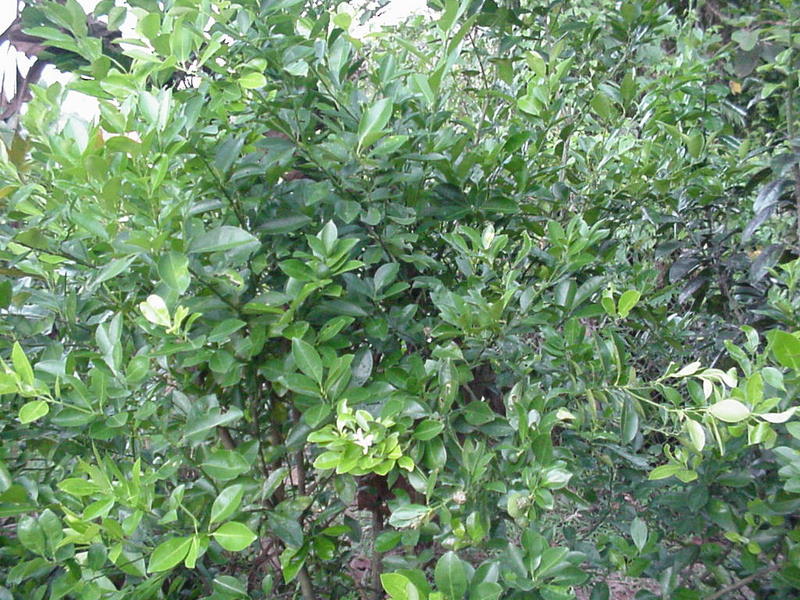
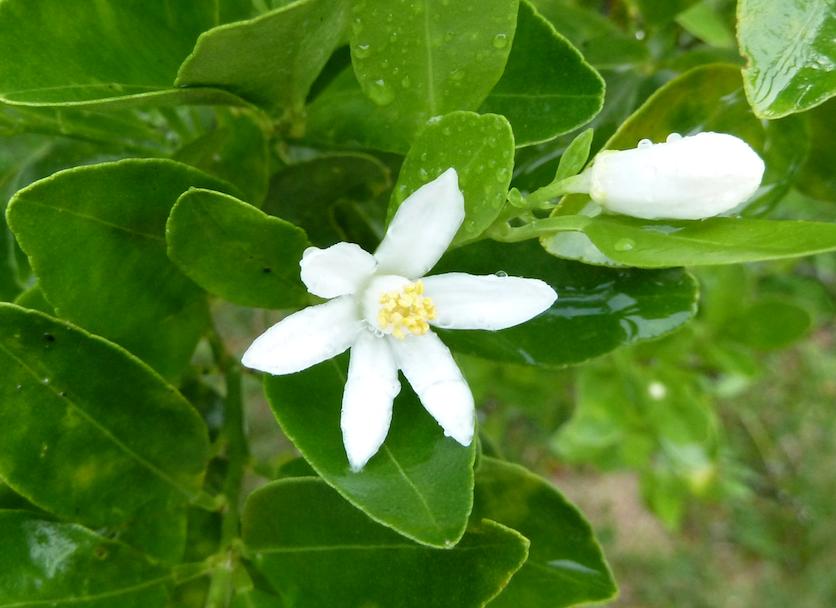
Cultivation
This species thrives in warm climates but can also grow in cool but frost-free areas. It thrives in an evenly distributed rainfall of 1500-2000 mm/year. Areas with long dry periods are equally suitable, provided irrigation is available. It is predominantly grown in the lowlands. It can grow over a wide range of soil types from clay loam to limestone to sand. However, it performs best in a well-drained, sandy or clay loam soil rich in organic matter with a pH of 5.5-7.0. It is moderately drought-tolerant but cannot withstand strong winds. [2]
Soil Suitability and Climate Requirement
The soil suitability and climatic requirement of C. x microcarpa or known as limau kasturi is similar to that of limau purut and limau nipis. It is well adapted on most soils but it is best suited to well-drained soils with water table more than 60 cm. The plant needs about 2000 to 3000 mm of rainfall, full sunlight and temperature of 25-38°C for optimum growth. [6]
Field Preparation
Land Preparation
Proper land preparation is very crucial for the optimum crop growth in the field. These activities include land clearing, disc ploughing and rotovation. This will help to improve soil structures, eliminates weeds and thus improve the crop growth environments. Triple Super Phosphate (TSP) and Ground Magnesium Limestone (GML) at the rate of 100 g/planting each is applied to each planting hole measuring 30 cm X 30 cm X 30 cm. [6]
Production of Planting Materials
Seeds are normally used as the source of planting materials. The C. x microcarpa seeds are relatively small and thus it should be firstly sowed into the germinating trays. The seeds will starts to germinate at about 2 weeks after sowing. Only the freshly collected are used since the seeds easily looses it viability during storage. The germinated seeds with 4-5 leaf stage are then transplanted to the polybags measuring 13 cm X 18 cm. The seedlings in the polybags are ready for field planting when it has grows to about 25 cm or 6 months in the polybags. [6]
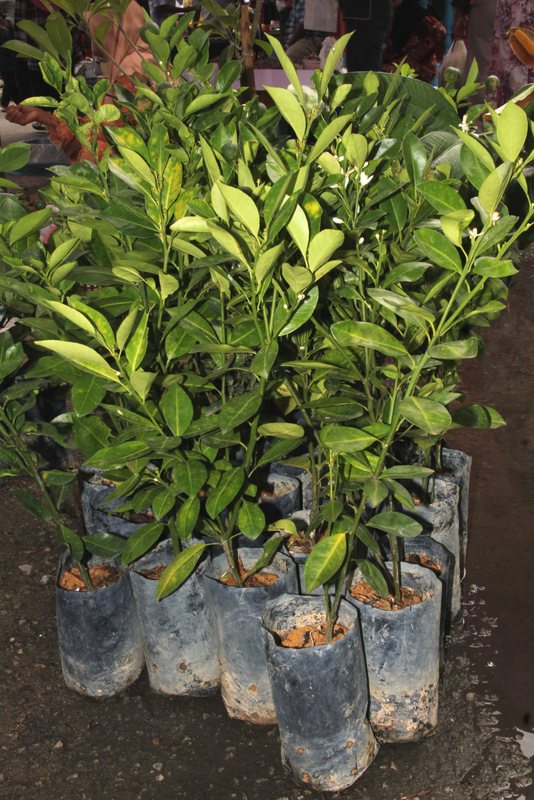
Field Planting
The recommended planting distance is 3 m between rows and 2.5 m between plants in the row. This will give the population density of 1300 plants/ha. Coconut leaves or rice straw should be used as the organic much to be applied around the growing point to conserve moisture and reduce weed infestations. Planting should be conducted during the beginning of the rainy seasons to reduce the effect of transplanting stress. [6]
Field maintenance
Fertilisation
Both the organic and inorganic compound fertilizer is required for the optimum crop growth. The requirement depends on the crop growth stages. The inorganic compound fertilizer (NPK:15:15:15) at the rate of 0.5 t/ha should be given for the first three years. When the crops starts flowering, the compound fertilizer with higher K2O at the rate of about 1.0 t/ha should be given in year 4 onwards. The organic fertilizer (such as chicken dung) requirement also depends on the crops maturity. The requirement is 4 t/ha for the first 3 years and increases to 7 t/ha from year 4 onwards. [6]
Weed Control
Weed problem can be minimized if the mulching is used especially during the early stages of crop growth. If necessary, the contact herbicides can be used. Manual weeding using grass cutter and inter-row cultivation can also be practiced. [6]
Water management
For optimum crop growth, supplementary irrigation should be given during the dry months. Drip irrigation is recommended since it cheaper, easy to handle, optimize water use and don’t need high-powered irrigation pumps and engines. [6]
Pest and Disease Control
The common pest of Citrus that includes C. x microcarpa is leaf miner (Phyllocnistis citrella). However the infestations are normally low and don’t need specific control measures. Canker and leaf greening can be very serious if not managed properly. The disease can be managed by pruning the infested plants. [6]
Harvesting
C. x microcarpa starts to produce fruits at 12 months after planting. The plants produce fruits through out the year but the maximum yield is obtained during the months of Mac to September. The fruits can be harvested at 3 weeks interval. The average fresh fruit yield for C. x microcarpa at 3rd year after field planting is 5 t/ha. The economic productive period for C. x microcarpa is about 12 years from planting. [6]
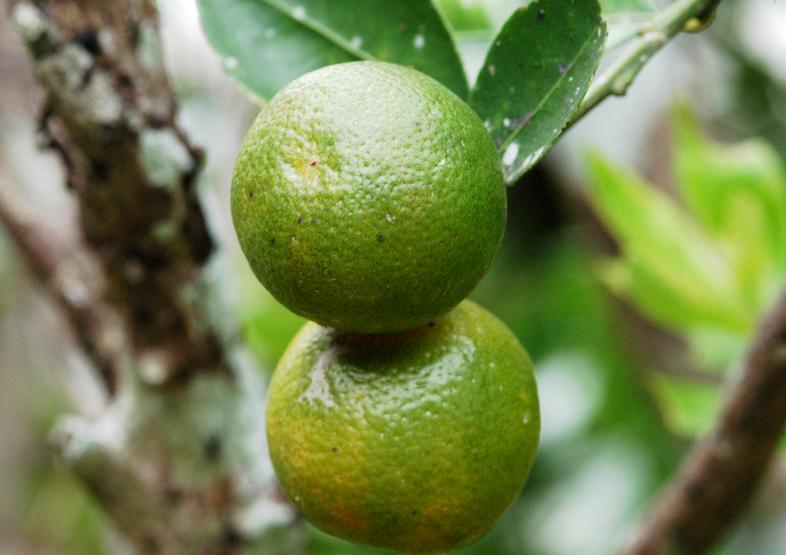
Postharvest handling
The fruits collected should be properly handled by using plastic containers to avoid contamination and fruit injury. The C. x microcarpa fruits should be immediately transported to processing centre for cleaning, grading and storing. [6]
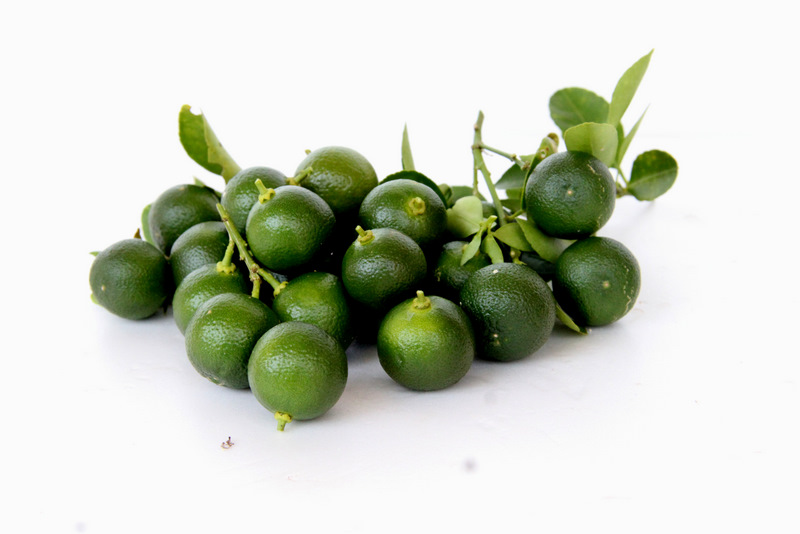
Estimated cost of production
The estimated annual cost of production for the fully grown crop (year 3 and above) is about RM10,200 per hectare. Based on the fresh yield of about 5.0 t/ha from the fully established crop, the production cost of fresh fruit is about RM2.00/kg. The production cost was estimated based on the cost of current inputs during writing of this article. [6]
Chemical Constituent
C. x microcarpa peel and leaves oils has been reported to contain aldehydes (e.g. acetaldehyde, decanaldehyde, nonanaldehyde, octanaldehyde, perillaldehyde), esters (e.g. geranyl acetate and neryl acetate), alcohols (e.g. ethanol, linalool, methanol, terpinen-4-ol, a-terpineol), hydrocarbons (e.g. 3-carene, limonene, myrcene, a-pinene, b-pinene, g-terpinene, terpinelene, valencene), sugars (e.g. glucose, fructose and sucrose), acids (e.g. dehydroascorbic acid, ascorbic acid, and malic acid), fatty acids (e.g. linoleic, oleic and palmitic acids), sesquiterpenes (e.g. hedycaryol , beta-sesquiphellandrene and alpha-eudesmol) [7], diosmin, quercetin [8], synephrine [9], polyoxygenated flavones (e.g. 3′,4′,5,6,7,8-hexamethoxyflavone; 4′,5,6,7,8-pentamethoxyflavone and 3′,4′,5,6,7-pentamethoxyflavone). [10]
Plant Part Used
Leaves, fruits, roots. [11][12][13]
Traditional Use
The fruit of C. microcarpa is being used in the treatment of pulmonary affections especially productive cough. It is believed to be an effective expectorant. For cough, colds and sorethroat in the Philippines a warm drink of kalamansi-ade is given, while in Malaysia the freshly squeezed juice to which is added some pepper makes an excellent expectorant. [11][12]
The juice from the fruit of C. microcarpa is applied directly on freckles to help lighten the spots. The same is used to treat acne vugaris and pruritus vulvae. The cut fruit is applied over insect bites to relieve itching and irritation. The rural population of Malaysia sometime use the juice of the fruit together with the saponaceous bark of Entada phaeseoloides as a shampoo to relieve itching and promote hair growth. To treat abscesses they sometimes make a poultice using pandanus leaves, salt and juice of C. microcarpa. [12]
Decoction of the leaves has been used to treat hypertension and diabetes, to ally nausea and fainting by squeezing the rind near the nostril to inhale. [2][11][13] When slightly diluted and warmed the juice of the fruit being given to facilitate the passage of stools. The Indian community uses this plant to treat scabies. The roots forms part of the potherb prepared to be given to women during childbirth. [12][13]
In Malaysia, the fruits are normally used as the seasoning for many foods such as soups and fried mee or rice. It also used for the preparation cordial or fruit juice. It is also being used as an antidote for poison, treatment of abscesses, sore throat, cough and nausea. The essential oil extract from the fruits are also used as the ingredients in the herbal bath and aromatherapy formulations. The fruits are also used to body odour and hair cleaning. [3][6][14][15]
Preclinical Data
Pharmacology
Antimicrobial activity
A cream formulated using extracts of fruit waste of C. microcarpa was made and tested against Trichophyton mentagrophytes and Candida albicans. The cream was found to be active in inhibiting the growth of these fungi. A scratch and patch test on guinea did not produce any irritation. [16]
Adrenergic activity
The drug synephrine had been isolated from the C. microcarpa wastes and leaves. Preliminary biological studies revealed that synephrine can inhibit the contraction of rat uterus previously injected with acetylcholine. Toxicity test LD50 in mice of the aqueous extract showed a median lethal dose of 23.8716 -+ 0.88g/kg. [9]
Toxicity
No documentation.
Clinical Data
No documentation.
Poisonous Management
No documentation.
Line Drawing
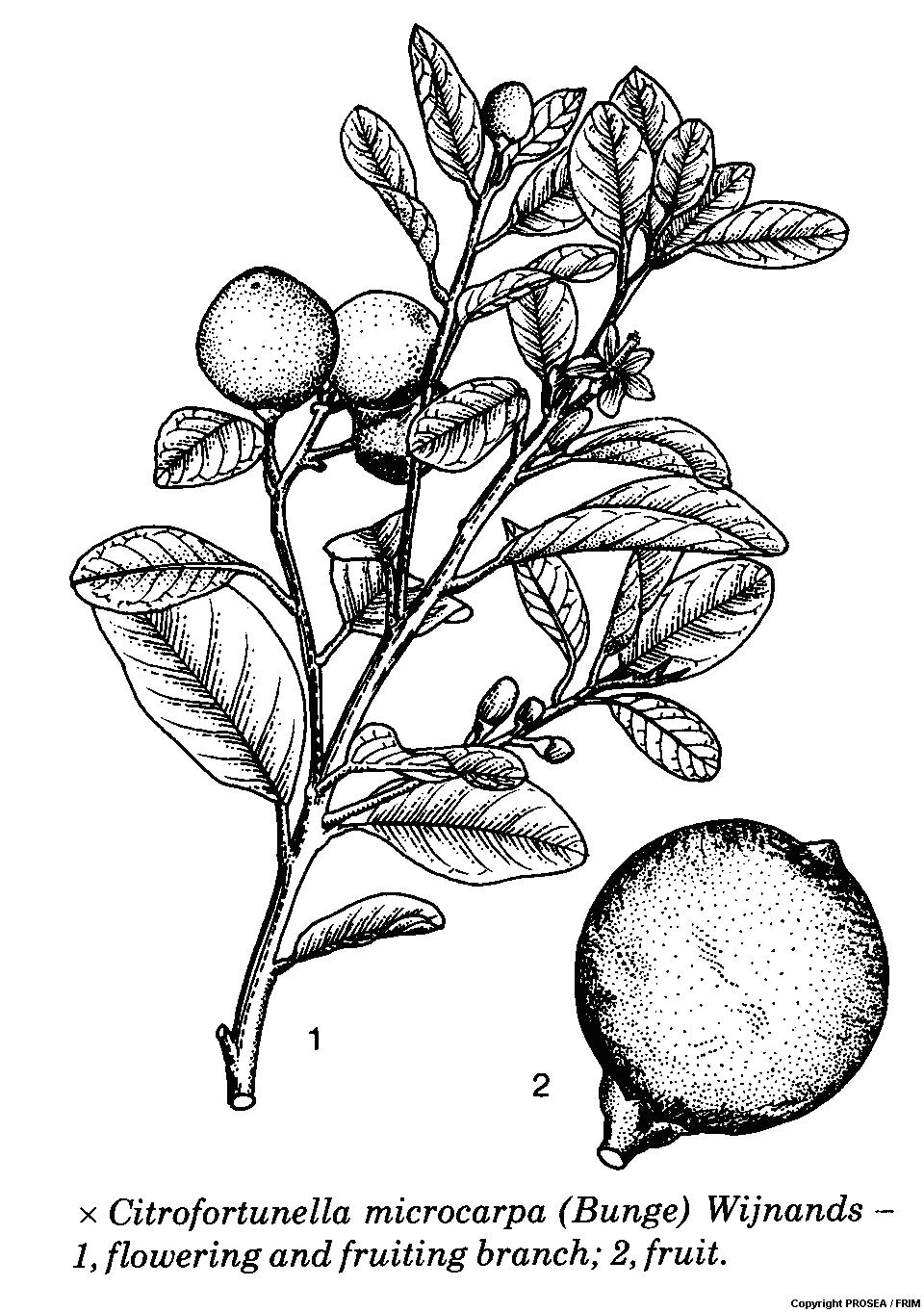
References
- The Plant List. Ver1.1. Citrus × microcarpa Bunge [homepage on the Internet]. c2013 [updated 2012 Mar 23; cited 2016 May 31]. Available from: http://www.theplantlist.org/tpl1.1/record/kew-2724243
- × Citrofortunella microcarpa (Bunge) Wijnands In: Verheij EWM, Coronel RE, editors. Plant Resources of South-East Asia No. 2: Edible fruits and nuts. Wageningen, Netherlands: Pudoc; 1991.
- Mat-salleh K, Latiff A. Tumbuhan ubatan Malaysia. Selangor, Malaysia: Universiti Kebangsaan Malaysia, 2002; p. 469-470.
- Lim TK. Edible Medicinal And Non-Medicinal Plants. Volume 4, fruits. Dordrecht, Netherlands: Springer, 2012; p. 865-870.
- Flora of China. Volume 11. Citrus Linnaeus. [homepage on the Internet]. No date [cited 2016 Jun 09] Available from: http://www.efloras.org/florataxon.aspx?flora_id=2&taxon_id=107164
- Panduan Penanaman Limau Kasturi. Kuala Lumpur: Jabatan Pertanian Semenanjung Malaysia.
- Jantan I, Ahmad AS, Ahmad AR, Ali NAMA, Ayop N. Chemical composition of some citrus oils from Malaysia. J Essent Oil Res. 1996Nov-Dec;8(6):627-632.
- Yuan-Chuen W, Yueh-Chueh C, Hsing-Wen H. The flavonoid, carotenoid and pectin content in peels of citrus cultivated in Taiwan. Food Chem. 2008 Jan 1;106(1):277-284.
- Briones AV, Sashida Y, Nonato M, et al. Synephrine: an adrenergic drug from calamansi wastes. Philipp J Sci (Philippines). 1995 Oct-Dec;124(4):311-325.
- Nisperos-Carriedo MO, Baldwin EA, Moshonas MG, Shaw PE. Determination of volatile flavor components, sugars, and ascorbic, dehydroascorbic, and other organic acids in calamondin (Citrus mitis Blanco). J Agric Food Chem. 1992;40 (12):2464–2466.
- Philippine Medicinal Plants. Kalamansi. Citrus microcarpa Bunge [homepage on the Internet]. No date [updated 2013 Jul; cited 2019 Dec 02] Available from: http://www.stuartxchange.org/Kalamansi.html.
- Morton J. Calamondin. In: Morton JF. Fruits of warm climates. Miami, Florida: Florida Flair Books, 1987; p. 176-178. In: Center for New Crops & Plants Products. Soursoup. [homepage on the Internet]. West Lafayette, Indiana: Purdue University; c2013 [cited 2019 Dec 02] Available from: http://www.hort.purdue.edu/newcrop/morton/calamondin.html
- Batugal PA, Kanniah J, Sy L, Oliver JT, editors. Medicinal Plants Research in Asia – Volume I: The Framework and Project Workplan. Serdang: International Plant Genetic Resources Institute-Regional Office for Asia, the Pacific and Oceania (IPGRI-APO), 2004; p. 161.
- Herbal Medicine Research Centre, Institute for Medical Research. Compendium of medicinal plants used in Malaysia. Volume 1. Kuala Lumpur: HMRC IMR, 2002; p. 196.
- Burkill IH. A dictionary of the economic products of the Malay Peninsula. Volume 1. London: Published on behalf of the governments of the Straits settlements and Federated Malay states by the Crown agents for the colonies, 1935; p. 2303-2304.
- Socorro BG. Preformulation, quality control, in vitro and preclinical studies of an antifuncal cream from the fruit pulp extract of Citrus microcarpa Bunge (Rutaceae). Emilio Aguinaldo College Research Bulletin.2007;6(1):27-36.


